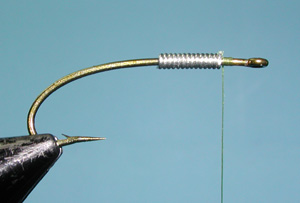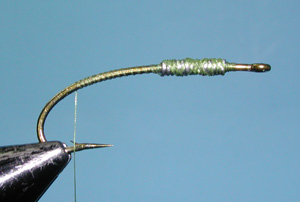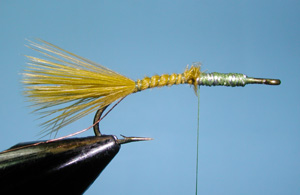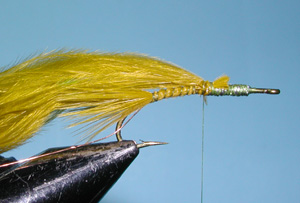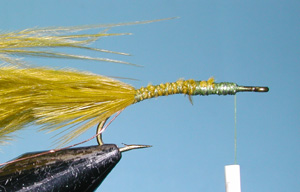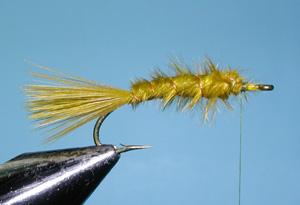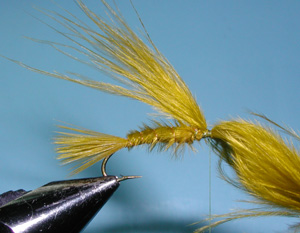Marabou Damsel Nymph – movement is the special trigger
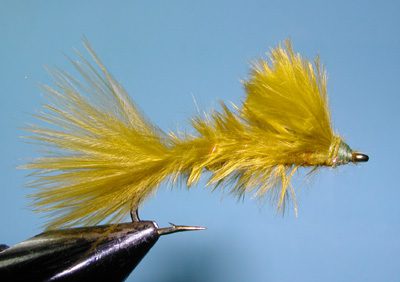
Marabou Damsel Nymph
Tying Instructions
| Materials
to Order Material, click the link |
|
|---|---|
| Hook | TMC 200R #8-12 |
| Thread | Danville Olive 6/0 |
| Head | Danville Olive 6/0 |
| Weight | 0.020 Leadfree wire |
| Body | Olive Marabou |
| Tail | Olive Marabou |
| Thorax | Olive Marabou |
| Wingcase | Olive Marabou |
| Ribbing | Copper wire |
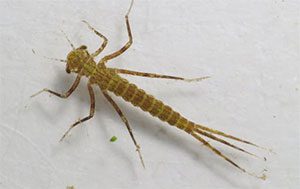

Randall Kaufmann
Marabou Damsel Nymph
Designed by Randall Kaufmann during the early 1980’s. Damsel nymphs are usually 1/2 to 1 inch long with a very streamlined body. They swim with a rhythmic wiggle, that ceases when the nymph needs to rest. During the resting cycle, the nymph slowly drifts downward.
Need for Movement
Randall noticed that most of the established damselfly nymph patterns at the time lacked the animation that he saw necessary to achieve the lifelike movement of the nymph within the water column. By incorporating Marabou for the tail, body, and wingcase, he succeeded in getting the animated movement of the fly. The colors of the marabou are also adaptable to the various colors that damsel nymphs acquire depending upon their environment. Most of these colors are olive, tan, and brown. An added benefit to this fly is that number of materials are kept to a minimum and it is easy to tie.
Variations
Some variations have been adapted to this pattern for specific locations around the Sierra. Notably, the Convict Damsel Nymph by Moose Patterson of Mammoth Lakes. Guide Tom Loe developed a nice variation with his Drifter’s Marabou Damsel Nymph and Emerger using a contrasting dubbed thorax and a sparse marabou abdomen. On the nymph, the marabou is secured to the top of the shank, ribbed with the thread to form a shellback, wingcase, and carapace. On the emerger, the tail and abdomen is secured to the the shank by a fine gold wire ribbing. The wing is a second piece of marabou that is secured over the dubbed thorax with the continuation of the gold wire ribbing. This provides a very durable tie down for the marabou wing.
Two other marabou damsels often used within the Sierra are the Damsel in Distress and the No Name Damsel. I don’t know who came up with these variations but the No Name is marketed by Umpqua Flies of Oregon.
Variations
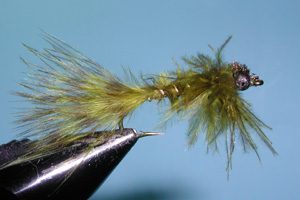
Convict Damsel Nymph
| Hook | TMC 200R #10-16 |
| Thread | Danville Olive 6/0 |
| Eyes | Small Black Chain bead |
| Body | Olive Marabou |
| Tail | Olive Marabou |
| Thorax | Olive Marabou |
| Wingcase | Peacock Herl |
| Ribbing | Small Oval Gold Tinsel |

Drifter’s Damsel Nymph
| Hook | TMC 3761 #12-16 |
| Thread | Danville Olive 6/0 |
| Eyes | Black Mono Eyes |
| Body | Olive Marabou |
| Tail | Olive Marabou |
| Thorax | PMD Superfine |
| Wingcase | Olive Marabou |
| Ribbing | Danville Olive 6/0 |
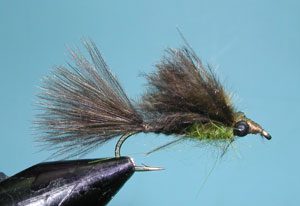
Drifter’s Damsel Emerger
| Hook | TMC 3761 #12-16 |
| Thread | Uni-thread Camel 8/0 |
| Eyes | Black Mono Eyes |
| Body | Olive Brown Marabou |
| Tail | Olive Brown Marabou |
| Thorax | Caddis Green Haretron |
| Wing | Olive Brown Marabou |
| Ribbing | Small Gold Wire |
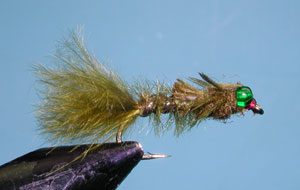
Damsel in Distress
| Hook | TMC 3761 #12-16 |
| Thread | Danville Olive 6/0 |
| Head | Olive Glass bead |
| Body | Dark Olive Simi Seal Dubbing |
| Tail | Olive Marabou |
| Thorax | Dark Olive Simi Seal Dubbing |
| Wingcase | Olive Marabou |
| Ribbing | Clear Vinyl Rib |
| Legs | Olive dyed Partridge |
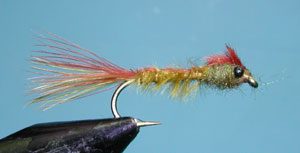
No Name Damsel
| Hook | TMC 3761 #10-16 |
| Thread | Uni-thread Tan 8/0 |
| Eyes | Black Mono Eyes |
| Body | Olive Marabou |
| Tail | Olive Marabou and Brown Marabou |
| Thorax | BWO Superfine |
| Wingcase and Shellback | Brown Marabou |
| Ribbing | Small Gold Wire |

